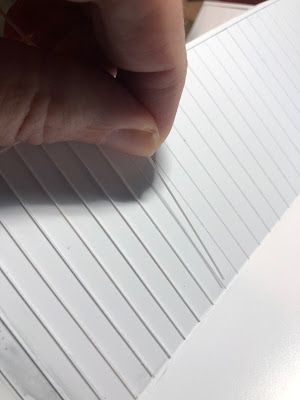Roof ribs, that is.
I've noticed a lot - the majority in fact, of the smaller industrial and agriculture related buildings along my prototype feature standing seam metal roofing of one form or another. Over the years I've tried all kinds of ways to model this, from paper with stripwood "ribs" to Builders in Scale metal roofing, such as on this model of Ben Thresher's mill.
Frankly, when it's painted and weathered the real metal roofing looks perhaps the best, except the material is just a little too thick, meaning for this building, with all its valleys and angles in the roof panels, I didn't think it would offer the best approach.
Instead I opted to go with Evergreen styrene metal roofing. This material is easy to work with, but the most tedious part is adding all those ribs to the slots in the roof sheet.
For a situation where the ribs end at the bottom of the roof, simply install the slightly long ribs along the length of the roof and then trim the ends flush. For areas where the ribs run between two other sections of roof, or one section and the peak, it's a little more tricky.
Here's how I do it:
1. After the roof panels are in place, and the strip styrene ridge cap (a 1x6 styrene strip at the top of the peak) I cut the rib overlength and insert the bottom of the rib into the slot. That plain styrene on the right is the subroof on another portion of the building - meaning the ribs are running between the ridge and another roof panel.
2. Once the bottom of the rib is in position, lock it in place with a slight amount of styrene cement or MEK applied with a needle applicator or a small brush.
3. Once the cement has dried, insert the rest of the rib into the remainder of the slot. I focus on getting the rib into the slot and with no gaps or waviness. Leave the rib overhanging the ridge cap slightly at this point.
4. Use flush cutting nippers to trim the rib just inside the base of the ridge cap. Then run styrene cement along the entire length of the rib.
5. Repeat Steps 1-4 ... a lot ... (!)






No comments:
Post a Comment